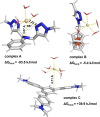Click Chemistry Derived Hexa-ferrocenylated 1,3,5-Triphenylbenzene for the Detection of Divalent Transition Metal Cations
- PMID: 39310204
- PMCID: PMC11411552
- DOI: 10.1021/acsomega.4c04300
Click Chemistry Derived Hexa-ferrocenylated 1,3,5-Triphenylbenzene for the Detection of Divalent Transition Metal Cations
Abstract
The 1,3-dipolar cycloaddition reaction (click chemistry approach) was employed to create a hexa-ferrocenylated 1,3,5-triphenylbenzene derivative. Leveraging the presence of metal-chelating sites associated with 1,2,3-triazole moieties and 1,4-dinitrogen systems (ethylenediamine-like), as well as tridentate chelating sites (1,4,7-trinitrogen, diethylene triamine-like) systems, the application of this molecule as a chemosensor for divalent transition metal cations was investigated. The interactions were probed voltammetrically and spectrofluorimetrically against seven selected cations: iron(II) (Fe2+), cobalt(II) (Co2+), nickel(II) (Ni2+), copper(II) (Cu2+), zinc(II) (Zn2+), cadmium(II) (Cd2+), and manganese(II) (Mn2+). Electrochemical assays revealed good detection properties, with very low limits of detection (LOD), for Co2+, Cu2+, and Cd2+ in aqueous solution (0.03-0.09 μM). Emission spectroscopy experiments demonstrated that the title compound exhibited versatile detection properties in solution, specifically turn-off fluorescence behavior upon the addition of each tested transition metal cation. The systems were characterized by satisfactory Stern-Volmer constant values (105-106 M-1) and low LOD, especially for Zn2+ and Co2+ (at the nanomolar concentration level).
© 2024 The Authors. Published by American Chemical Society.
Conflict of interest statement
The authors declare no competing financial interest.
Figures







Similar articles
-
Reaction of the coordinate complexes of inositol hexaphosphate with first row transition series cations and Cd(II) with calf intestinal alkaline phosphatase.J Inorg Biochem. 1995 May 1;58(2):89-107. doi: 10.1016/0162-0134(94)00038-c. J Inorg Biochem. 1995. PMID: 7769385
-
Amberlite XAD-7 impregnated with Xylenol Orange: a chelating collector for preconcentration of Cd(II), Co(II), Cu(II), Ni(II), Zn(II) and Fe(III) ions prior to their determination by flame AAS.Fresenius J Anal Chem. 2000 Jul;367(6):562-7. doi: 10.1007/s002160000395. Fresenius J Anal Chem. 2000. PMID: 11225832
-
Divalent metal derivatives of the hamster dihydroorotase domain.Biochemistry. 1999 Aug 3;38(31):9964-70. doi: 10.1021/bi990859x. Biochemistry. 1999. PMID: 10433703
-
Ferrocenylated 1,3,5-triphenylbenzenes for the electrochemical detection of various cations or anions.Dalton Trans. 2021 Jun 22;50(24):8426-8433. doi: 10.1039/d1dt01287h. Dalton Trans. 2021. PMID: 34037029
-
Rationally designed phenanthrene derivatized triazole as a dual chemosensor for fluoride and copper recognition.Spectrochim Acta A Mol Biomol Spectrosc. 2020 Mar 5;228:117758. doi: 10.1016/j.saa.2019.117758. Epub 2019 Nov 9. Spectrochim Acta A Mol Biomol Spectrosc. 2020. PMID: 31753648
References
-
- Xia H.; He J.; Peng P.; Zhou Y.; Li Y.; Tian W. Synthesis and Photophysical Properties of Triphenylamine-Based Dendrimers with 1,3,5-Triphenylbenzene Cores. Tetrahedron Lett. 2007, 48 (33), 5877–5881. 10.1016/j.tetlet.2007.06.052. - DOI
-
- Mongin O.; Brunel J.; Porrès L.; Blanchard-Desce M. Synthesis and Two-Photon Absorption of Triphenylbenzene-Cored Dendritic Chromophores. Tetrahedron Lett. 2003, 44 (14), 2813–2816. 10.1016/S0040-4039(03)00455-6. - DOI
LinkOut - more resources
Full Text Sources
